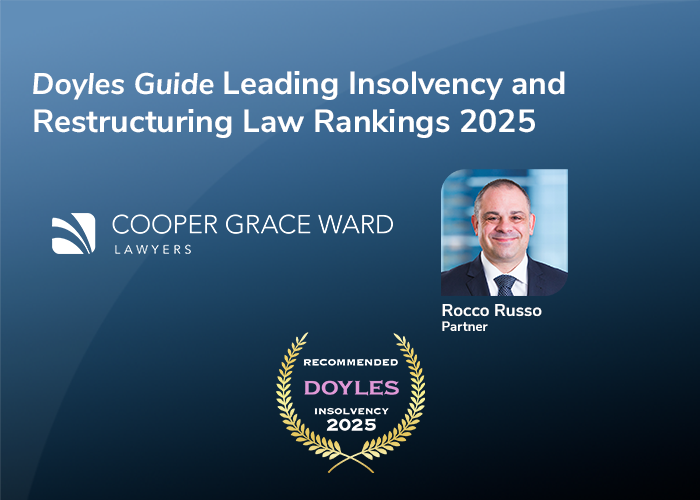When a loan is secured by guarantees given by more than one person, disputes can often arise between co-guarantors as to who should bear the burden of paying out the loan, and in what proportions. The High Court has this week provided clarification on the rights of co-guarantors.
Background
The law generally presumes that each co-guarantor should contribute equally to the payout of the debt and, if one guarantor pays more than their share, they are entitled to seek a contribution from the other guarantors to compensate them for their overpayment.
But what happens when one guarantor has negotiated, for themselves, an agreement that the creditor will not enforce the guarantee against that guarantor in exchange for a payment towards the debt less than that guarantor’s share?
In the recent decision of Lavin v Toppi [2015] HCA 4, the High Court has conclusively determined that the guarantor who negotiated the deal with the creditor can still be called on by a co-guarantor to make a further contribution to any amount subsequently paid out by another creditor.
Case facts
Ms Lavin and Ms Toppi were both directors of Luxe Studios Pty Ltd (Luxe). They were also co-guarantors under a loan given by NAB to Luxe for $7,768,000.
Luxe went into receivership and NAB recovered some money from the sale of a security property, but there was still an unsatisfied liability of a little over $4 million, which NAB demanded from the co-guarantors. When immediate payment was not made, NAB sued the guarantors for the debt.
Ms Lavin made a cross-claim against NAB seeking relief under the Trade Practices Act 1974 (Cth) and the Contracts Review Act 1980 (NSW). After filing her defence and cross-claim, she was able to negotiate with NAB to settle the court proceedings against her in exchange for her making a payment that included $1.35 million towards the guaranteed debt.
The deed of settlement contained a clause requiring the existing proceedings against Ms Lavin to be dismissed and, importantly, a covenant that NAB would not sue Ms Lavin for the guaranteed debt. A covenant not to sue is often used in these kinds of matters instead of a more traditional release because a release of one co-guarantor can, in some circumstances, release all co guarantors.
In this case, NAB wished to preserve its rights to pursue Ms Toppi for the balance of the debt, and did so, ultimately recovering the balance of the debt ($2.9 million) from the proceeds of the sale of the family home of Ms Toppi and her husband.
Ms Toppi then made a claim for contribution against Ms Lavin claiming that she should pay around $775,000 (being one half of the difference between the amounts paid by Ms Lavin and Ms Toppi). Ms Lavin defended the claim and the case was ultimately decided by the High Court on 11 February 2015.
Decision
Ms Lavin’s defence was based on the legal argument that, in order to sustain a claim for contribution, Ms Toppi needed to show that the liabilities of Ms Lavin and Ms Toppi were ‘co-ordinate’, meaning the liabilities must have the same nature and quality. (Generally, joint and several liabilities to guarantee the same debt will be regarded as co-ordinate.)
Ms Lavin argued that, from the time that she obtained a covenant from NAB that it would not sue her for the guaranteed debt, her liability to NAB was ‘qualitatively different’ from Ms Toppi’s liability because Ms Toppi’s liability was still enforceable by the bank but Ms Lavin’s liability was not.
Therefore, Ms Lavin argued that, at the time Ms Toppi paid the $2.9 million to NAB, there was no co ordinate liability to support a claim for contribution against Ms Lavin.
The High Court rejected Ms Lavin’s argument for two reasons:
- First, the High Court found that the covenant not to sue given by NAB did not alter the nature or quality of Ms Lavin’s liability to NAB. NAB’s promise not to enforce that liability through legal proceedings was a separate matter that did not alter the nature of the underlying liability.
- Second, a claim for contribution arises when the guarantor is called on to pay the debt, not when the overpayment is made. Ms Toppi had a right to contribution from Ms Lavin from the date of NAB’s demand. The settlement agreement between NAB and Ms Lavin (to which Ms Toppi was not a party) could not affect Ms Toppi’s existing right to claim contribution.
The High Court therefore decided that Ms Lavin had to make a contribution of an additional amount of approximately $775,000 to Ms Toppi despite Ms Lavin’s settlement with NAB.
Comment
It is common for guarantors and their advisers to negotiate settlements with creditors such as banks in which they seek to pay less than the full amount of their liability. Indeed, modern court procedures encourage settlements and compromise, even in straightforward debt recovery matters, because they are said to promote certainty and finality.
When Ms Lavin reached a settlement agreement with NAB, she no doubt thought that things had been resolved and she would have no further liability.
The case serves as an important reminder to co-guarantors who are being offered a settlement that will not resolve claims against a co-guarantor, that they will not necessarily be protected from a claim by the co-guarantor if the co-guarantor subsequently has to pay more money to settle or satisfy the claim against them.
When negotiating settlements in these situations, parties need to either factor in the possibility of further exposure or seek to negotiate a different structure for the settlement, if that is possible.
One option when negotiating to settle a liability owed jointly and severally with another person is to ensure that all parties sign the settlement agreement and the claims are resolved together.
Otherwise, where that is not possible (and sometimes it is not), the wording and structure of the settlement agreement will be crucial in protecting the parties to the settlement from subsequent claims from persons who are not a party to the settlement.
If you would like more information about these issues, please contact Justin Ditton on +61 7 3231 2984 or Rocco Russo on +61 7 3231 2468.




